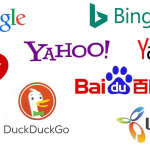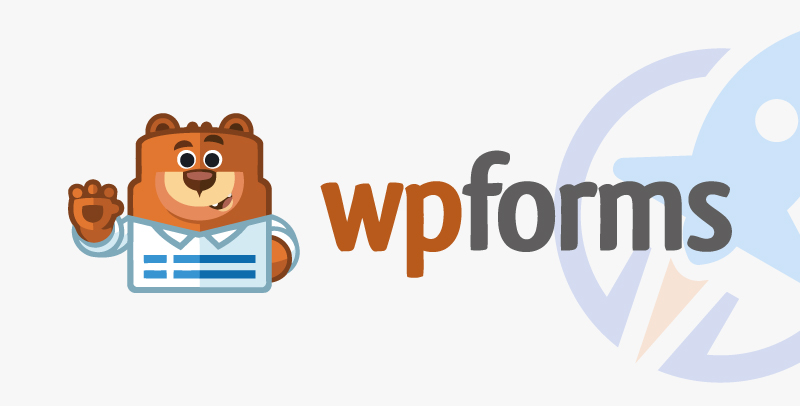Office 365 users can attest that Microsoft Outlook is the communication workhorse for anyone who sends and receives emails. There’s no denying that it’s an invaluable tool, but it lacks much functionality beyond this. That’s why integrating it with the best Outlook CRM is the perfect way to expand its usefulness and empower your sales and marketing teams.
An Office 365 Outlook CRM integration allows you to do so much more with your email service, including team collaboration, sales management, email marketing, and lead generation. In fact, bringing these formidable tools together is the ideal way to boost team efficiency and productivity across all departments.
This blog post highlights the best CRM solutions for Outlook users, breaking down their pros, cons, and pricing. We’ll also detail the benefits of using an Outlook CRM and some of the key features you should consider when looking for the best Office 365 CRM.
COMPARE
Which CRM has the features you need?
Our interactive worksheet compares the benefits offered by Nutshell, your existing contact management solution, and any other CRMs you’re currently evaluating.
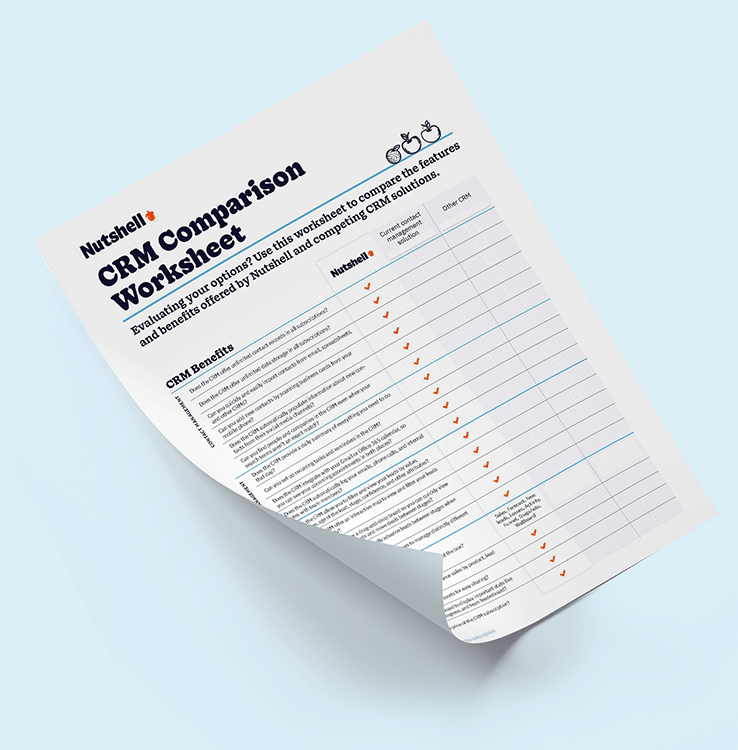
Benefits of using an Outlook CRM
Perhaps you’re still on the fence about an Outlook-customer relationship management (CRM) system marriage and need to know what it can do for your organization before you begin your CRM search. The benefits of implementing an Office 365 Outlook CRM within your operation are many and include the following:
- Streamline communication: With your favorite email service and CRM neatly bundled together, you can read and respond to emails and view calendars from one convenient dashboard.
- Maximize productivity: Bringing your Outlook messages into your CRM system saves time and improves your team’s productivity, inevitably impacting your bottom line.
- Enhance customer experiences: Your CRM creates a platform for better team collaboration, making sure all team members are on the same page and increasing customer experiences at every touchpoint.
- Improve data management: Melding your Office 365 and Outlook with a CRM gives you a centralized repository of data shared across your company, encouraging more transparency between departments and improved data accuracy.
- Consolidate processes: Bring sales, marketing, support, and other departments together through a CRM, creating a powerhouse team working together to boost revenue and growth.
Essential Office 365 Outlook CRM features
As you begin your quest for the best CRM for Outlook and Office 365, you’ll need a checklist of critical features to guide you through the decision-making process. Here are some of the core features you’ll want to keep an eye out for:
- Office 365 integration: Most importantly, make sure that Microsoft Outlook integrates effortlessly with your chosen CRM solution. Choose a CRM that stipulates Office 365 integration and has a support team ready to guide you through the process.
- Contact management: Pick a CRM with robust features to create, manage, and share detailed contact records, notes, and related activities.
- Sales automation: Look for a CRM solution that offers automation capabilities, allowing your team to automate non-selling and repetitive tasks and giving them more time to focus on relationship building.
- Email marketing: Find a CRM system with email marketing features that let you set up email campaigns, drip sequences, newsletters, and broadcasts and track open and click-through rates.
- Reports and analytics: Ensure your chosen CRM provides detailed reports for the metrics that matter most and offers the option to customize reporting to suit your needs.
- Lead capturing and scoring: A CRM platform that makes bringing new leads into the system effortless, with lead capturing features like web form and landing page builders, as well as automated lead assigning and scoring.
- Pipeline management: Your CRM should let you customize your pipeline stages, automate tasks and lead progression based on specified criteria, track sales performance, and much more.
- Team collaboration: Choose a CRM system that facilitates collaboration and information sharing, helping teams across departments improve productivity and outcomes.
The 6 best CRMs for Outlook and Office 365
Now that you have a better idea of the advantages of a great Outlook CRM and what features you should look out for, let’s dive into the best CRM options on the market for your Outlook integration.
1. Nutshell

Nutshell is the all-in-one CRM solution for teams that need an easy-to-use system that works harmoniously with Outlook and Office 365. With Nutshell, you get two solutions for Outlook integration, namely:
- Standard Nutshell Outlook integration for users working on the Nutshell platform
- Nutshell Office 365 Outlook add-on for users working in Outlook (free via Microsoft AppSource)
What’s great about Nutshell is that even users on the entry-level Foundation plan have access to this integration and add-on, unlike some of its competitors.
SO MANY INTEGRATIONS
Is Nutshell a perfect match for your favorite software?
Nutshell integrates with tons of software, both natively and through Zapier. See if your favorites are on the list.

Key features
These are the key Nutshell features you should be aware of:
- Native integration: Implement Nutshell’s native one-click Office 365 and Outlook integration and eliminate the need to use multiple tools, allowing you to work directly from Nutshell.
- Contact management: Bring contact records into one central database accessible across departments to elevate data management and sharing.
- Email marketing: Take advantage of Nutshell’s email marketing tools to create powerful email campaigns and sequences using designer templates.
- Pipeline management: Use advanced pipeline management features and tailored sales processes to turn contacts into customers.
- Task automation: Automate repetitive sales-related tasks and activities with Nutshell’s sales automation tools to save time and boost productivity.
- Reporting: Create custom reports to measure performance, identify trends, and spot areas for improvement.
- Team collaboration: Bring sales, marketing, and support teams together with better team collaboration through the Nutshell platform.
- Outlook add-in: Manage contacts, tasks, and activities from your email interface with the Outlook add-in.
Pros
When you choose Nutshell as your CRM partner for Outlook integration, you can look forward to the following advantages:
- Easy two-way synchronization of your Outlook emails, calendars, tasks, and contacts.
- See all relevant information related to contacts, including designation, lead evolution, and all interactions.
- Free Outlook add-on to use across sales, marketing, and support teams in Outlook.
- Access to sharable email templates and an AI email writing assistant.
- Advanced pipeline creation and management for optimal lead nurturing.
- Detailed lead and sales reports for evaluation and campaign optimization.
- Nutshell mobile app for staying in touch with customers and colleagues on the go.
Cons
Apart from the incredible features and pros highlighted above, Nutshell still comes with a few cons, including:
- No free plan—Only a 14-day free trial, but with access to all the features.
- Limited click-to-call and phone recordings on entry-level plans.
- Email click tracking and notifications are only available from the Pro plan upward.
Price
The following pricing illustrates Nutshell’s affordability:
- Starting at $16 per user per month.
A 14-day free trial is available (no credit card required).
2. Microsoft Dynamics 365

Microsoft users who want their CRM system to integrate with all their Microsoft tools may consider Microsoft Dynamics 365 as an Office 365 Outlook CRM. With it, you can bring Microsoft products like Excel, OneNote, Teams, OneDrive, and more into a unified system to streamline processes.
Key features
You can expect to receive the following features when you choose Microsoft Dynamics 365:
- Sales reports: Extract standard sales and performance reports and view updated metrics on your dashboard.
- Lead management: Bring prospect information into your CRM for qualification and pipeline assignment, which you can manage through Microsoft Dynamics 365.
- Audience segmentation: Segment your audience for improved targeting through email and marketing campaigns.
- Product management: Oversee product-related information and activities, including pricelists and bundling.
- Order administration: Facilitate orders and generate quotes and invoices from within your CRM software.
Pros
Let’s take a look at the benefits Microsoft Dynamics 365 has to offer its users:
- An advanced system for lead scoring, pipeline monitoring, and sales forecasting.
- A native solution that integrates with all Microsoft software for a combined, central platform.
- Integrates with LinkedIn Sales Navigator, letting you gather essential lead information from the platform.
Cons
Here are some Microsoft Dynamics 365 pitfalls to bear in mind:
- A costly solution compared to its peers.
- Comprises complex advanced tools, creating a learning curve and making user adoption a challenge.
- Software is designed to focus on sales activities, while customer support, marketing, and other operations require add-ons.
Price
Your Microsoft Dynamics 365 pricing looks like this:
- Starting at $65 per user per month.
- 30-day free trial available.
3. HubSpot CRM

HubSpot is well-known in sales and marketing circles as one of the first enhanced CRM systems. Some of its popularity stems from the free tools and integrations it offers, in addition to its paid plans. This system lets you synchronize data, contact information, templates, and more from your CRM interface.
With HubSpot’s CRM solution, you can manage contacts either through your CRM software or directly from Outlook.
Key features
What features can you expect with the HubSpot CRM? Are are a few of the primary features that come with this software:
- App integrations: Access the HubSpot app marketplace, where you can shop for third-party integrations, including the HubSpot Outlook integration.
- Email management: Send individual or bulk emails and track their performance through the HubSpot CRM platform.
- Outlook synchronization: Synchronize your Outlook emails going out and coming in so you can see the full picture in both your Outlook and HubSpot interfaces.
- Lead tracking: Keep an eye on leads and deals through a single pipeline.
- Activity tracking: Manage contact and company information and monitor interactions through data stored within the records.
Pros
Some of the upsides to incorporating HubSpot CRM into your organization include:
- CRM system suitable for sales, marketing, and customer service teams.
- User-friendly, with a straightforward Outlook integration process.
- Get the HubSpot CRM extension for Outlook and gain access to data, templates, and more from your CRM via Outlook.
Cons
You might want to keep the following cons in mind when considering HubSpot CRM:
- A free plan with limited capabilities exists, but paid plans can prove costly.
- You’ll need HubSpot CRM’s Professional plan to set up email sequences or use email automation tools.
- Upgrading to a paid plan is required to sync more than five email templates.
Price
You can expect the following costs associated with HubSpot CRM:
- Paid plans start at $15 per month per seat.
- There is a free plan available with limited tools and features.
4. Zoho CRM
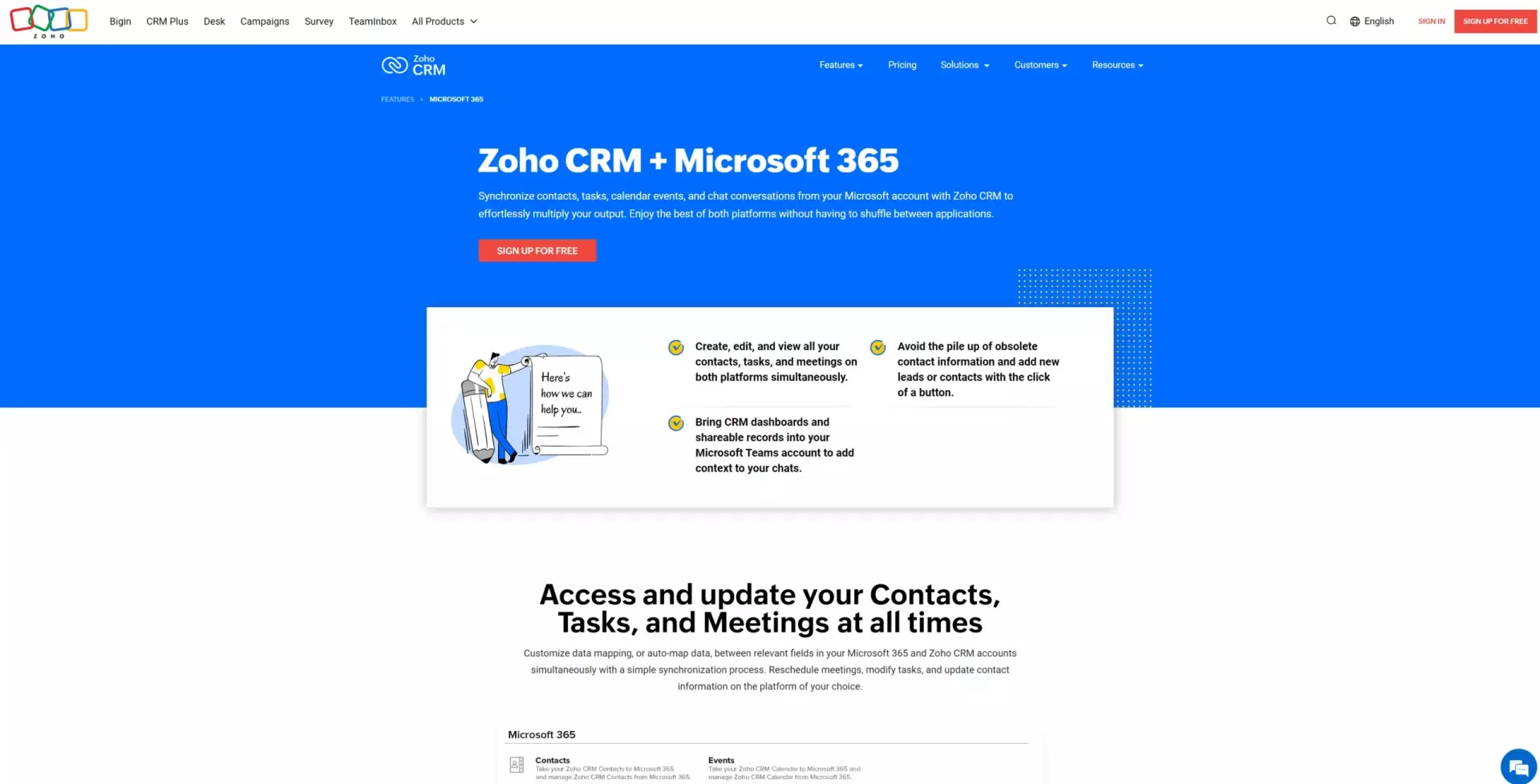
Although noted as one of the more difficult CRM platforms to use, Zoho CRM offers a free Outlook email add-in that provides several helpful features accessible directly through Outlook. Its on-platform Outlook CRM integration is also relatively robust and can be customized to meet your needs. However, those with less CRM experience will likely face a significant learning curve.
Key features
Zoho CRM offers the following useful features with Outlook integration:
- Outlook add-in: A free Outlook add-in that lets you draw information from Zoho for use in Outlook, such as creating contacts and leads, adding notes, recording activities, and tracking campaigns.
- Record keeping: Store documents and information regarding sales activity and customer interactions.
- Sales tracking: Monitor leads and deals for one pipeline, no more.
- Email design: Create and store templates for quick and easy email creation.
- Standard reporting: Access basic sales reports to determine sales rep performance and conversion rates.
Pros
Opting for Zoho CRM provides you with the following benefits:
- Offers the ability to score leads automatically using AI.
- Zoho CRM Outlook add-in can be used in Outlook on the free plan but in a limited capacity.
- Integrates with phone and live chat communications tools for enhanced connectivity.
Cons
On the downside, Zoho CRM fails to impress in the following areas:
- Integrating Zoho CRM with Outlook to work through Zoho can only be done on a paid plan.
- Incredibly complex and confusing user interface.
- Poor customer support when you need assistance.
- Syncing events from Zoho CRM to Outlook requires a paid plan.
Price
While Zoho CRM’s pricing isn’t bad, you’ll need to upgrade to gain access to many of the essential sales and marketing features. Here’s what you can expect to pay:
- The entry-level Standard plan is $18 per month per user.
- A limited free plan is available.
- Zoho CRM offers a 15-day free trial for each pricing tier.
5. Pipedrive
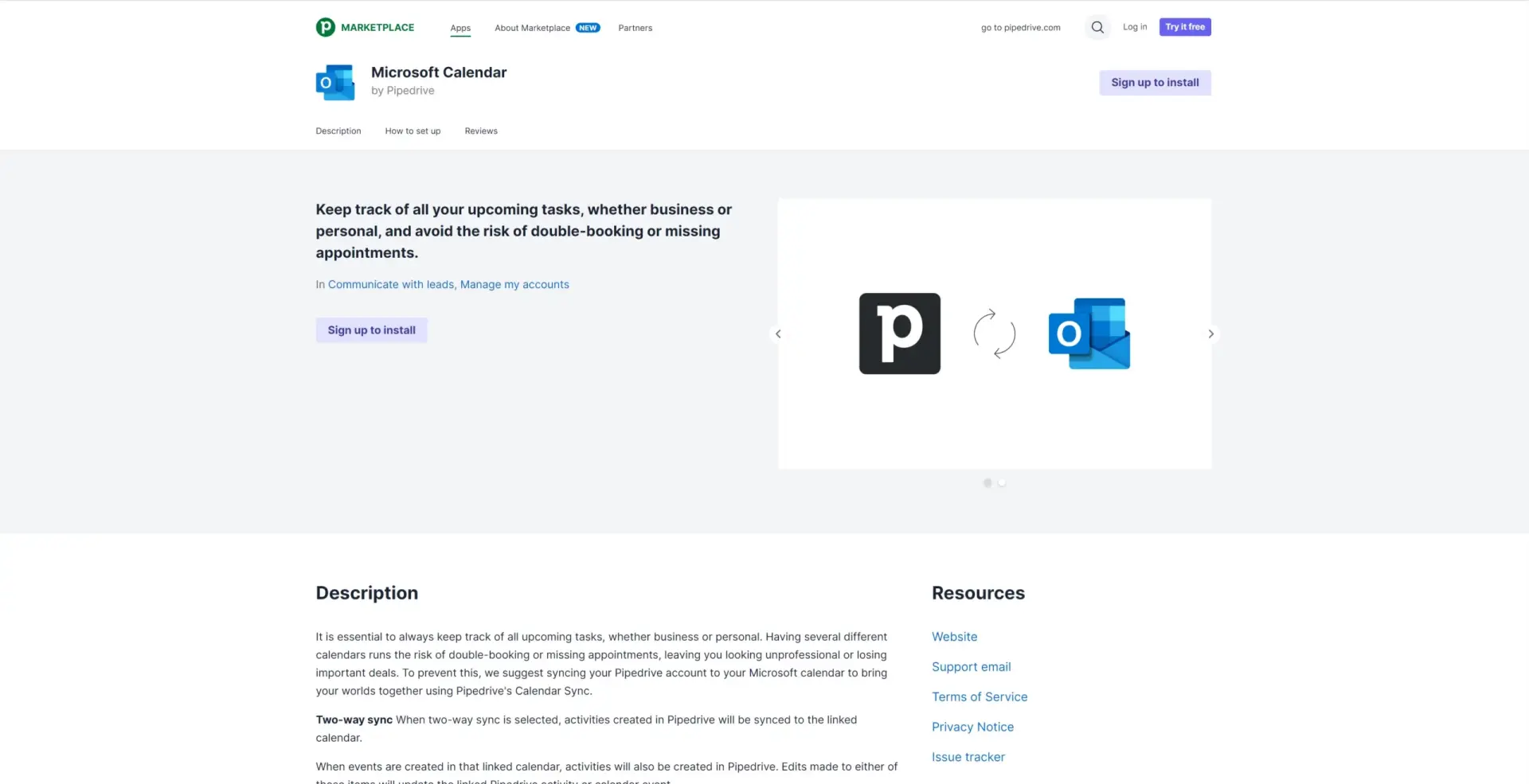
Companies that want additional features to create processes and workflows for departments other than sales, marketing, and customer support may find Pipedrive a useful CRM. In fact, it has become a popular CRM for teams that want to add project management operations to their CRM system.
Pipedrive is also a reliable CRM for Outlook integration, allowing you to sync everything from emails to contact records and even scheduled video conference meetings. Let’s examine Pipedrive’s features in more detail to determine whether it’s the best Outlook CRM for your business.
Key features
When it comes to features, you’ll have access to the following in Pipedrive:
- Comprehensive syncing: Sync your calendars and contacts with your Office 365 account for access in Outlook.
- Tracking capabilities: Track lead and contact interactions and activity from your CRM or Outlook interface.
- Store attachments: Save all documents attached to emails to your CRM contact records.
- AI assistant: Offers AI assistance for reminders and notifications, tips, task and activity updates, and sales forecasting.
- Sales reports: Draw reports to track sales activities and targets.
Pros
The advantages of signing up with Pipedrive for Outlook and Office 365 integration include:
- On-platform project management features—no third-party integrations required.
- Schedule in-person, virtual, and conference call meetings in Pipedrive and sync them with your Outlook calendar.
- See more than just events and communication data from your CRM in Outlook with syncing for sales activities also available.
Cons
Unfortunately, a few cons are associated with using Pipedrive as your chosen Office 365 Outlook CRM, such as:
- No Pipedrive plugin for Outlook, so you can’t access synchronized data from your Outlook interface.
- Not equipped with many high-level features needed by bigger businesses and enterprises.
- Outlook integration is only available for Pipedrive customers on the Advanced plan and above.
Price
Signing up with Pipedrive for Outlook integration will cost as follows:
- Outlook integration is possible from the Advanced plan upward, costing $29 per month per user.
- You can sign up for a 14-day free trial to test the software.
6. Insightly
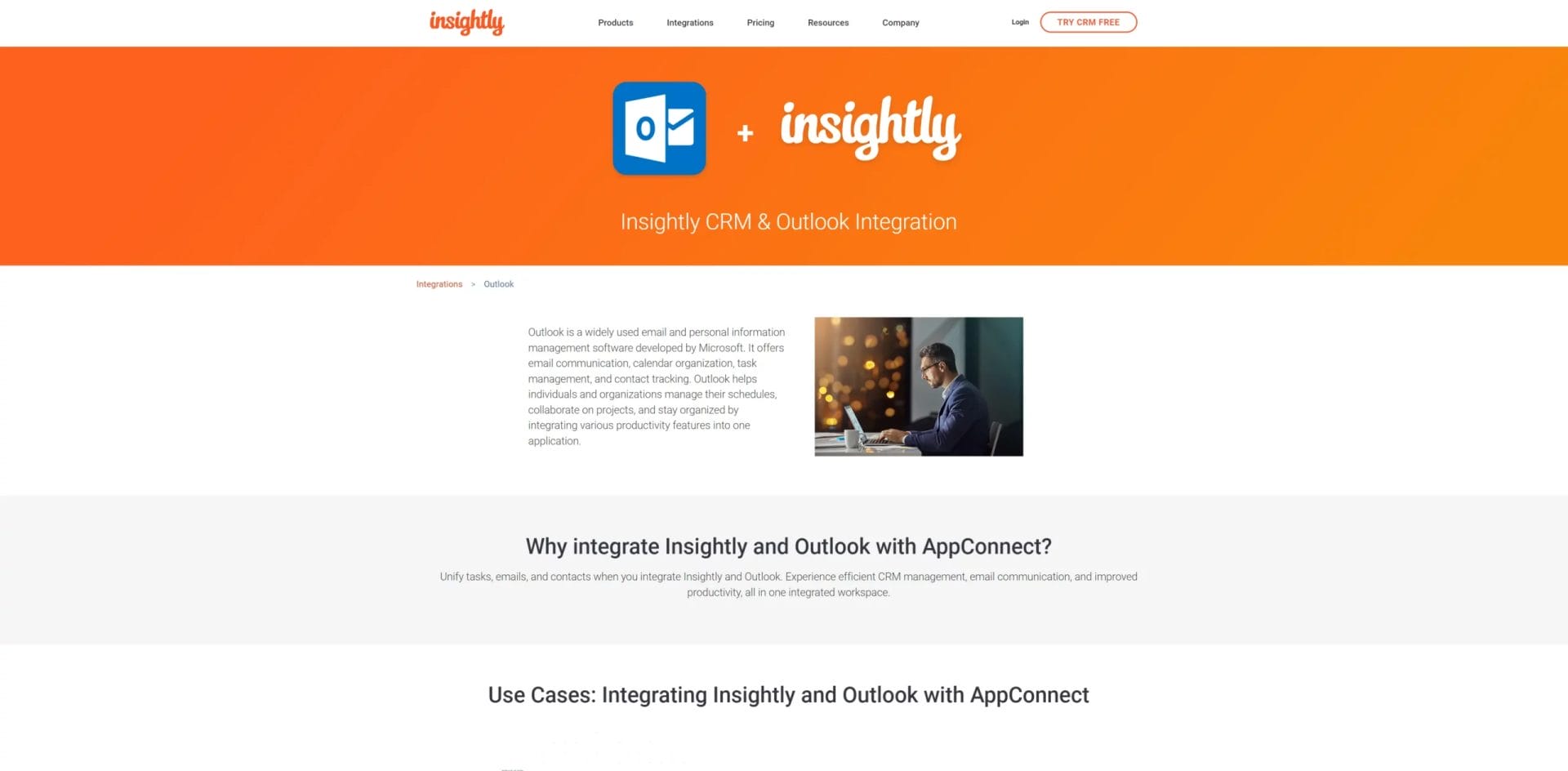
Insightly is a CRM platform that allows sales, marketing, and project management teams to work together through one platform. With Insightly, you can synchronize Outlook and CRM data both ways, meaning you can access the information you need from both the Outlook and Insightly interfaces.
Is Insightly the best CRM for Office 365 and Outlook for your business? Let’s find out.
Key features
A few standout features you can look forward to when working with Insightling include:
- Event syncing: Easily sync your meetings and events between Insightly and Outlook to access them on other platforms.
- Save emails: Save your Outlook emails, contacts, and notes in Insightly for better contact record-keeping in a central database.
- Several integrations: The platform offers several integration options with prominent apps over and above Outlook.
- Lead management: Use Insightly’s pipeline and lead management tools to turn your Outlook contacts into leads as you filter them through to your sales pipelines.
- Project management: Leverage project and task management features to bring all your company’s departments together through your CRM platform.
Pros
These are the positives when it comes to using Insightly:
- A user-friendly CRM with a minimal learning curve for new users.
- Share Outlook emails, contacts, tasks, events, and more with Insightly so you can access and work with everything from your CRM.
- Track performance with real-time insights and reports, viewable from your Insightly dashboard.
Cons
Consider these cons when looking at Insightly as an Outlook CRM option:
- A basic CRM which doesn’t allow for significant customization for a more tailored solution.
- Limited customer support and support team knowledge.
- Extremely high pricing for the features you get.
Price
So, what will investing in Insightly cost you? Here’s a breakdown of the costs:
- Paid plans start at $29 per user per month, billed annually.
- There is a free plan with limited features for a maximum of two users, but you won’t have access to the Outlook integration.
- You can sign up for a 14-day free trial for any of the paid plans.
Looking for an easy-to-use CRM with all the features you need to boost sales?
Nutshell has what you’re looking for.

How to choose the best Outlook CRM for your business
Sourcing the best Office 365 Outlook CRM for your organization begins with this list of factors you should consider before making your final decision:
- Outlook integration: Make sure your chosen CRM offers integration with Outlook and an Outlook plugin, allowing you to sync data on both platforms and choose to work in Outlook or your CRM.
- Ability to scale: Your business is growing, and it stands to reason that you want your tech stack to grow with you. Choose a CRM that offers you the flexibility to scale when your business does.
- Within budget: Consider your CRM implementation budget, including costs beyond the fees paid for the software. Bear in mind that you may need to employ a CRM implementation team, and additional training costs may be involved for new users.
- Positive reviews: As an integral part of any business’s tech stack, CRMs are reviewed regularly online. Read user reviews on G2, Capterra, and GetApp to determine the CRM’s rating and whether it meets your needs.
- Option to customize: Not all businesses and workflow processes are the same, so a certain level of CRM customization is expected. Ensure you can customize the CRM’s fields, dashboards, pipelines, and reports.
- Mobile capabilities: Look for a CRM with a mobile app compatible with both Apple and Android devices. With a mobile app, you should have access to all core CRM functionality on the go.
- Easy to use: Finding a user-friendly CRM will make adoption easier and should reduce the level of training needed to get your team onboard. When CRM systems are complex and difficult to understand, teams often struggle to take to the software, leaving many unengaged.
- Demo and trial: Make sure you can register for a live CRM demo with the ability to ask the host questions about the product. You should also have access to a free trial of the full product for a specified period without paying or providing your credit card details.
Get started with the best CRM for Outlook today!
For an affordable CRM solution with more than just the core CRM features and comprehensive Outlook integration, look no further than Nutshell. Our CRM offers users stress-free sales and marketing features that help teams close more deals and boost revenue.
Enjoy a host of advanced CRM features packaged in one of the most user-friendly interfaces you’ll experience. In fact, because Nutshell is so easy to use, it has become one of the few CRM systems sales and marketing teams actually love using.
Apart from the broad array of features mentioned in the post, you can look forward to thousands of app integrations, incredible lead generation, competitor tracking, marketing add-ons, and award-winning customer support from our Ann Arbor-based support team.
Give Nutshell a try today, and find out why it’s one of the top-rated CRM systems on G2. Start your 14-day free trial today, or contact our sales team to discuss your needs and view a live demo.
Want to kick the tires a bit?
No problem. To see if Nutshell is the right choice for your sales team, start a 14-day free trial today!

The post The 6 Best Outlook CRMs for Seamless Office 365 Integration appeared first on Nutshell.

